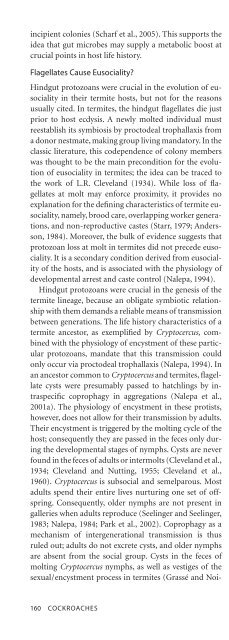Cockroache; Ecology, behavior & history - W.J. Bell
Cockroache; Ecology, behavior & history - W.J. Bell
Cockroache; Ecology, behavior & history - W.J. Bell
You also want an ePaper? Increase the reach of your titles
YUMPU automatically turns print PDFs into web optimized ePapers that Google loves.
incipient colonies (Scharf et al., 2005). This supports the<br />
idea that gut microbes may supply a metabolic boost at<br />
crucial points in host life <strong>history</strong>.<br />
Flagellates Cause Eusociality?<br />
Hindgut protozoans were crucial in the evolution of eusociality<br />
in their termite hosts, but not for the reasons<br />
usually cited. In termites, the hindgut flagellates die just<br />
prior to host ecdysis. A newly molted individual must<br />
reestablish its symbiosis by proctodeal trophallaxis from<br />
a donor nestmate, making group living mandatory. In the<br />
classic literature, this codependence of colony members<br />
was thought to be the main precondition for the evolution<br />
of eusociality in termites; the idea can be traced to<br />
the work of L.R. Cleveland (1934). While loss of flagellates<br />
at molt may enforce proximity, it provides no<br />
explanation for the defining characteristics of termite eusociality,<br />
namely, brood care, overlapping worker generations,<br />
and non-reproductive castes (Starr, 1979; Andersson,<br />
1984). Moreover, the bulk of evidence suggests that<br />
protozoan loss at molt in termites did not precede eusociality.<br />
It is a secondary condition derived from eusociality<br />
of the hosts, and is associated with the physiology of<br />
developmental arrest and caste control (Nalepa, 1994).<br />
Hindgut protozoans were crucial in the genesis of the<br />
termite lineage, because an obligate symbiotic relationship<br />
with them demands a reliable means of transmission<br />
between generations. The life <strong>history</strong> characteristics of a<br />
termite ancestor, as exemplified by Cryptocercus, combined<br />
with the physiology of encystment of these particular<br />
protozoans, mandate that this transmission could<br />
only occur via proctodeal trophallaxis (Nalepa, 1994). In<br />
an ancestor common to Cryptocercus and termites, flagellate<br />
cysts were presumably passed to hatchlings by intraspecific<br />
coprophagy in aggregations (Nalepa et al.,<br />
2001a). The physiology of encystment in these protists,<br />
however, does not allow for their transmission by adults.<br />
Their encystment is triggered by the molting cycle of the<br />
host; consequently they are passed in the feces only during<br />
the developmental stages of nymphs. Cysts are never<br />
found in the feces of adults or intermolts (Cleveland et al.,<br />
1934; Cleveland and Nutting, 1955; Cleveland et al.,<br />
1960). Cryptocercus is subsocial and semelparous. Most<br />
adults spend their entire lives nurturing one set of offspring.<br />
Consequently, older nymphs are not present in<br />
galleries when adults reproduce (Seelinger and Seelinger,<br />
1983; Nalepa, 1984; Park et al., 2002). Coprophagy as a<br />
mechanism of intergenerational transmission is thus<br />
ruled out; adults do not excrete cysts, and older nymphs<br />
are absent from the social group. Cysts in the feces of<br />
molting Cryptocercus nymphs, as well as vestiges of the<br />
sexual/encystment process in termites (Grassé and Noirot,<br />
1945; Cleveland, 1965; Messer and Lee, 1989), are a<br />
legacy of their distant gregarious past. In the ancestor<br />
Cryptocercus shared with termites, an obligate relationship<br />
with gut symbionts, intergenerational transmission<br />
via proctodeal trophallaxis, and subsociality were thus a<br />
co-evolved character set (Nalepa, 1991; Nalepa et al.,<br />
2001a). Proctodeal trophallaxis in young families of a<br />
Cryptocercus-like ancestor assured not only passage of<br />
cellulolytic flagellates between generations, but also passage<br />
of the entire complex of microorganisms present in<br />
the hindgut fluids. Trophallaxis thus conserved relationships<br />
between microbial taxa within consortia, allowing<br />
them to develop interdependent relationships by eliminating<br />
redundant pathways. The metabolic efficiency<br />
of these consortia consequently increased, shifting the<br />
cost-benefit ratio in favor of increased host reliance. The<br />
growing dependence of the host on gut microbes, in turn,<br />
reinforced selection for assured passage between generations<br />
via subsociality and trophallactic <strong>behavior</strong>. The<br />
switch from horizontal to vertical intergenerational<br />
transmission of gut fauna was thus one of the key influences<br />
in the transition from gregarious to subsocial <strong>behavior</strong><br />
in the common ancestor of Cryptocercus and termites.<br />
It also set up one of the pivotal conditions allowing<br />
for the transition to eusociality by establishing the <strong>behavior</strong>al<br />
basis of trophallactic exchanges (Nalepa et al.,<br />
2001a).<br />
The hypothesis that the loss of protozoan symbionts at<br />
molt was influential during the initial transition to eusociality,<br />
then, is not supported. The interdependence that<br />
the condition enforces on hosts nonetheless played a key<br />
role after the initial transition from subsociality to eusociality<br />
(detailed below). Subsequent hormonal changes<br />
related to developmental stasis and caste evolution, and<br />
the associated loss of protozoans at molt resulted in a<br />
“point of no return” (Hölldobbler and Wilson, 2005),<br />
when individuals became incapable of a solitary existence.<br />
DOUBLE SYMBIOSIS: THE ROLE<br />
OF BACTEROIDS<br />
A hindgut filled to capacity with a huge complex of interacting<br />
microbiota was not the only symbiotic association<br />
influential in the evolution of termite eusociality.<br />
Grassé and Noirot (1959) noted nearly a half-century ago<br />
that the two taxa bracketing the transition from cockroaches<br />
to termites share a unique double symbiosis: an<br />
association with cellulolytic flagellates in the hindgut, and<br />
endosymbiotic bacteria housed in the visceral fat body.<br />
Cryptocercus is the only cockroach that has the former<br />
symbiosis, which it shares with all lower termites, and<br />
160 COCKROACHES


